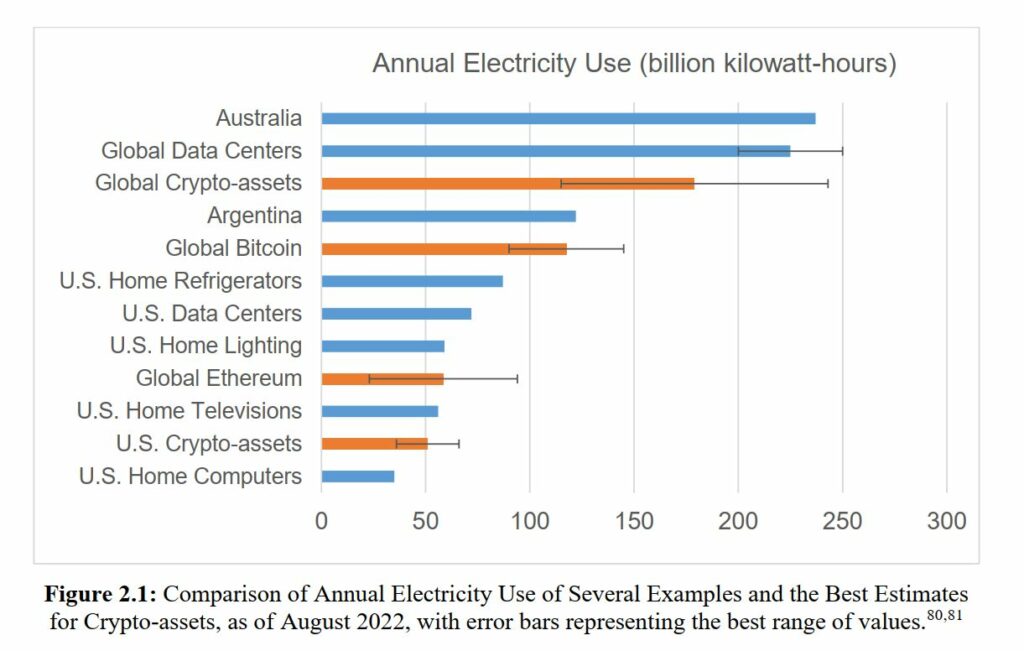Introduction
C. S. Lewis once said, “Miracles do not, in fact, break the laws of nature.” Although the following is not a miracle in itself, it could at least be a miracle in the making. A unique development has occurred in the crypto space. The likes of which have, probably, never been seen before in the history of technology. And as far as nature is concerned, it is good for the environment and not violating its laws.
NFTs, mining, and cryptocurrencies, including Bitcoin, have been attacked in the past year due to their massive energy consumption. The environmental community has primarily criticized cryptocurrencies, and in parts, rightfully so.
There is an image problem.
One of the main concerns has been the massive carbon footprint created by mining rigs worldwide. Over the past five years, the usage of electricity by cryptocurrencies like Bitcoin and Ethereum, which up until now used to be close to half a percent of all electricity consumed in the world, has doubled tenfold. The bad reputation was cemented with articles in mainstream Financial Times, The Economist, New York times, and the Twitter-sphere being on fire.
An official report published by the White House on 9 September 2022 outlined the ‘First-Ever’ Comprehensive Framework For Cryptocurrency. A report which outlined the current state of the annual electrical usage of crypto assets. Bitcoin and Ethereum are the biggest (due to their popularity and use).

100 billion kilowatt hours
As the White House correctly points out, the main problem was the combined annual electricity consumption of all global crypto-assets was almost the same as the total electricity consumed by all global data centers combined, and the amount of energy and emissions were higher than most countries on the planet. In its own right, Ethereum could have consumed nearly 100 billion kilowatt hours per year.
According to Kristin Smith, executive director of the Blockchain Association, critics have criticized the report for focusing on the negative aspects of crypto and saying the report has missed the mark and “kicked the can down the road” on crypto regulation.
Moreover, she argues that today’s executive order reports and summaries are a missed opportunity for the U.S. crypto industry to cement its leadership. These reports are meant to serve as part of a broader effort by the United States government and stakeholder groups to improve crypto asset regulation. Still, they focus on risks rather than opportunities and do not provide substantive recommendations for how the United States can promote its booming crypto industry.
The massive consumption of energy was unsustainable. A change was desperately needed and has been in the making for a while. However, this seems to have been flying under the radar for quite some time. In its recent report, even the White House seemed ignorant of these up-and-coming changes in the crypto space – thinking in particular about Ethereum’s Merge.
However, there are ways to reduce the impact of crypto on the environment. As you will see, the narrative is about to change in a big way.
What changed and how?
For cryptocurrencies to reach their full potential, the energy consumption, the perceptions, and the lousy image surrounding them need to be addressed and resolved.
Polygon made a big announcement in April 2022. In this manifesto, Polygon outlined a broader vision for sustainable development, including the goal of becoming carbon-neutral by 2022. The company has also created a series of climate change initiatives within its ecosystem and has committed $20 million toward a series of community initiatives that utilize technology to combat climate change.
The transition to Ethereum 2.0.
With Ethereum’s main net merging with Beacon Chain’s proof-of-stake system, this was likely one of the most highly anticipated events in 2022.
“The Merge” resulted from this merger, marking the end of Ethereum as we know it today and giving birth to Ethereum 2.0 – the consensus algorithm based on stake. This was a landmark moment, and the significant impact is partly due to greater efficiency. Ethereum was estimated to perform 900 billion calculations per second before the Merge, which is no longer required.
With Proof of Stake (POS), transactions and new blocks are confirmed using randomly selected validators. In contrast, Proof of Work (POW) verifies transactions and adds new blocks using a competitive validation method. For a comprehensive understanding of POS vs. POW, please click HERE.
The Ethereum Merge cut global energy consumption by 0.2%, one of the most significant decarbonizing events in history, Vitalik Buterin tweeted on the Merge day.
The overhaul cut Ethereum’s energy use by 99.99% and carbon-dioxide emissions by 99.992%. In a year of electricity use, the network emits less CO2 than a few hundred U.S. households, according to Crypto Carbon Ratings Institute (CCRI). This is a radical change.
The figure above shows this radical change. ETH PoS (Proof of Stake) is now making a significantly smaller environmental footprint than YouTube, Gold Mining, Netflix, or Gaming in the United States.
Toward a bright future – This technology has an important role to play.
While many environmentalists have criticized cryptocurrencies, there are additional ways to reduce their impact. While ESG is essential, we must keep the broader perspective in mind. There is a view and a belief that the technology underpinning blockchain and crypto over the past decade and a half could also be a vital enabler of a sustainable energy transition.
To unlock the benefits of cryptocurrencies, addressing their energy use and changing how they are perceived is necessary. Cryptocurrencies can promote financial inclusion by driving innovation in financial services. The industry has recognized it has an environmental problem, has acted upon it, and has options for further reducing its carbon footprint.
According to World Economic Forum (WEF), cryptocurrencies have the potential to provide accessibility and automation of financial services, which can promote financial inclusion. The World Bank estimates show a positive case for crypto regarding social impact. Jean Pesme, the World Bank’s Global Director of Finance, Competitiveness & Innovation, highlights how blockchain could disrupt aspects of economic development from trading to remittances.
The case for crypto is strong, for example, in terms of its potential for social impact. Cryptocurrencies can promote financial inclusion by driving innovation in financial services, like peer-to-peer micropayments, potentially providing accessibility to anyone with an internet connection and reducing costs by automating financial services at scale.
Taking the next step
Yet, there are more ways to reduce the carbon footprint of cryptocurrency and NFTs. One way is to use renewable energy sources like solar or wind power to generate the electricity used to power mining operations. Another way is to use more efficient mining hardware that consumes less electricity.
As the world looks to transition to more environmentally-friendly energy sources, the role of technology will be crucial. In terms of potential impact, crypto and blockchain stand out. These technologies can enable the energy transition by reducing energy consumption and increasing transparency, thereby keeping stakeholders accountable.
An energy project’s environmental impact could be better assessed using blockchain’s distributed ledger to track energy consumption. In addition, blockchain-based transactions can be verified and authenticated without central authorities. As a result, energy consumption could be reduced since transactions could be verified faster.
Crypto assets (such as tokens) are also emerging as a new way to finance energy projects. These assets are often environmentally conscious, with some funds explicitly targeting projects with a positive environmental impact. In addition, crypto assets offer several benefits for energy projects, including 24/7 trading and global access to capital. As a result, they could play a key role in enabling the energy transition.
An excellent example of this is KlimaDAO which demonstrates how a new ecosystem—powered by decentralized governance and smart contracts—can be built that explicitly uses carbon and puts it to work. As the interface to an emerging market for on-chain carbon, the DAO assigns resources to produce unique products intended to catalyze the market.
Play2Learn Foundation recognizes and notes that the web3 industry is making good progress and can play a vital role in helping other sectors of our economy and society change to more sustainable models and processes.
In the wake of Ethereum’s big Merge, the environmental movement and blockchain developers should collaborate more closely.
We could all be part of completing the most extensive quest of our lives by saving the planet. After all, chances are that it not only would be blockchain’s killer app, but it would also complete the final stage of a miracle in the making.
Written by
David Garpenståhl
Executive Director
Play2Learn Foundation
About Us
The Play2Learn Foundation is a 501(c)(3) nonprofit that provides gamers and entrepreneurs with inspiration, education, and the resources needed to navigate the emerging web3 landscape by promoting financial inclusion and technological literacy.
Forest Conservation and Sustainability
The Play2Learn Foundation works with partners and programs to offset carbon emissions, preserve rainforests, and reforest them to protect and increase biodiversity. We drive the adoption and growth of a clean and sustainable crypto-carbon ecosystem.
With 1.6 billion people without access to a bank account, the Play2Learn Foundation focuses on numerous educational initiatives and social impact programs to promote financial inclusion and technological literacy to young gamers around the globe.
Sources:
https://www.nytimes.com/interactive/2021/09/03/climate/bitcoin-carbon-footprint-electricity.html
https://www.whitehouse.gov/wp-content/uploads/2022/09/09-2022-Crypto-Assets-and-Climate-Report.pdf
https://www.worldometers.info/co2-emissions/co2-emissions-by-country/
https://en.wikipedia.org/wiki/List_of_countries_by_electricity_consumption
https://blog.polygon.technology/polygon-is-going-carbon-negative-in-2022-with-a-20-million-pledge/
https://www.polygon.com/features/22914488/video-games-climate-change-carbon-footprint
